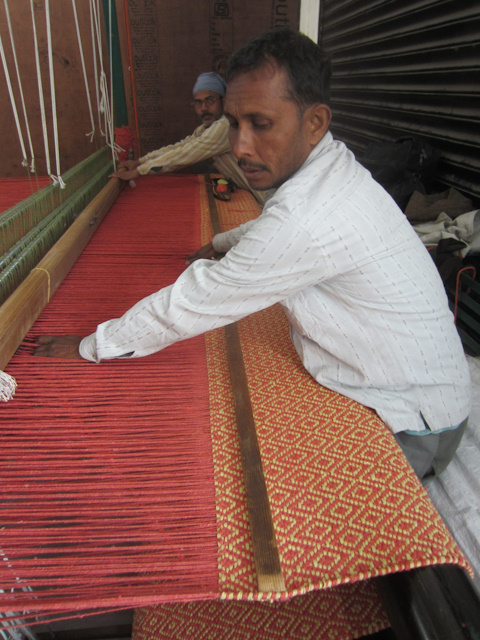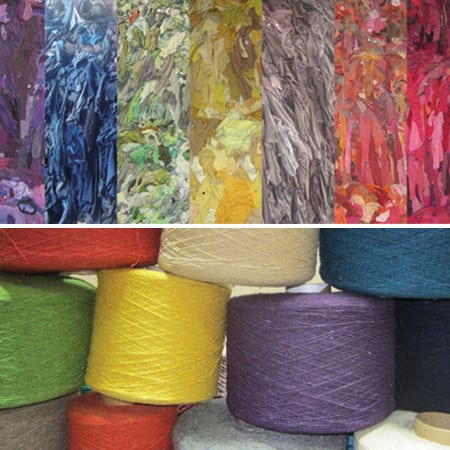Our Eco Commitment

Our Mission: to make beautiful, comfortable, durable, safe rugs without harming the Earth.
We’ve written up specific company guidelines to ensure that we never lose sight of this mission.
The environment comes first.
We will always search out the most Earth-friendly way to make our rugs. We will always seek to lower our environmental impact, attempting to inspire others in our industry to do the same.No dyes. Ever.
We have learned, through our own painstaking research, that even green alternatives like vegetable dyes require chemicals and detergents, creating large amounts of harmful waste-water. We will NEVER use dyes to create our products.No chemicals.
We will NOT use chemicals of any kind in the production of any of our products. No flame retardants, no pesticides, no harmful detergents, nothing.No latex.
We will NEVER use latex in any of our products, so you never have to worry about potentially dangerous off-gassing.Safe for people: Ours, and yours.
For us, Earth-friendly means caring for air, water, and soil, but also for people. To that end, we will always place a strong emphasis on a safe and fair working environment. We respect our employees and their unique talents, and we will always treat them with compassion. Our employees (and employees of any of our partners) will be fairly paid and considerately managed. They are (and will always be) of legal age, and will never be bound by unfair work contracts. We will always extend our workplace safety and compassion to our customers. Just as our workplace will be safe to weave in, our products will be safe to roll around on. We will always treat our customers with the utmost respect, and provide tireless service for them.
We offer rugs meeting guidelines in three fabrics: Eco Cotton, Undyed Wool, Organic Cotton.
Recycled Eco Cotton Rugs

Less than 15% of clothing and textiles are donated for re-use or recycling. The rest becomes landfill.

What is Eco Cotton?
Our Eco Cotton rugs are why Hook & Loom exists. They represent the finish line in a long journey to make the perfect Earth-friendly cotton rugs. Not only do these eco cotton rugs produce no harmful waste, they keep existing cotton fibers out of landfills! We do this with a unique four-step process.
The Process
- Clean donated textiles are meticulously sorted into piles by color.
- Snaps, zippers, and buttons are removed and the textiles pulled apart until they are back to colored fiber form.
- This fiber is then spun into brand new colorful yarns.
- We lovingly hand-weave this new yarn into delightful and durable new eco cotton rugs.
We think this technique is innovative and wonderful. We’re the only company making cotton rugs this way and our process isn’t patented. In fact, we wish all cotton rugs were produced like this. Hopefully, someday (with your help), they will be!
Not Just “Recycled” Cotton
Maybe you’ve heard of recycled cotton fiber rugs before. Unfortunately, companies advertising 100% recycled cotton fiber are using (and dyeing) new cotton. This “recycled” cotton is actually new cotton that’s been rejected from production of goods which require long cotton fibers. How can you tell? True recycled cotton is never 100% cotton. There are always small amounts of polyester and other fibers in the mix, from pockets, linings, thread, etc.
We make rugs we’re proud of, and rugs you can be proud to own.
Read how we arrived at Eco Cotton.
Our Eco Cotton Journey
Current “Recycled” Cotton
Encouraged at the thought of recycled cotton rugs, we delved further into the process used by current textile manufacturers. We were disappointed to learn that recycled means dyeing new cotton that just didn’t meet specifications. It was new cotton that’s grown and dyed, and has never known another use. We had to do better.
Vegetable Dyes
We looked extensively into vegetable dyeing, spending weeks making and testing them on a range of yarns. The end results were gorgeous, the rugs held up to use. The first half of our purpose was fulfilled.
Unfortunately, to use these Eco-friendly dyes, we had to pre-soak our yarn in chemical mordants to get the colors to stick, use salt to fix the colors, and use detergents to remove the dye afterwards. We couldn’t manage this without creating large amounts of waste-water infused with these chemicals, detergents, and salt. It wasn’t Earth-friendly after all. A dead end. We realized dyeing, of any kind, was a big part of the problem.
Finally, Eco Cotton
When mulling the problem of Earth-friendly cotton over with a textile expert, he mentioned a friend who’d figured out how to turn discarded textiles into yarn. Our founder, Whitney Selke, met this friend and studied his technique. The process was enthralling. Heaping piles of textiles adorned his workspace, sorted by color family, each containing a myriad of shades. It was beautiful chaos. When a given pile was shredded, mixed, and pulled apart, the result was fiber in a uniform average shade, with a lovely, slightly heathered appearance. Once this fiber was spun into yarn, it was pristine, totally indistinguishable from virgin dyed yarn in appearance. In fact, it was better than virgin dyed yarn on so many levels: The yarn wouldn’t fade, or bleed, since the fibers had already been washed many times over. And the yarn, and rugs, were beautiful, with no need to grow new cotton, and actually reducing landfill impact instead.
And that’s how we arrived at Eco Cotton!
100% Natural Undyed Wool Rugs
The Wool Challenge
We knew we wanted to offer environmentally responsible wool rugs. For all the many benefits of cotton, the feel of a thick, luxurious wool rug on your feet is unmatched. To bring wool rugs to market, we knew we had to marry the elegance and comfort of wool with our environmentally aware mission.

The Palettes of Nature
Since “No Dyes” is one of our company commandments, it was a no-brainer that we’d offer natural colors. We set off to research. Our most popular cotton colors are natural, taupe, grey, tan, and brown, and sheep come in all these colors. Nature is wonderful! We were encouraged, but there was more to be done.
Hand-woven, Hand-bound
Using undyed, natural wool is important, but it wasn’t enough. Many wool rugs are made with latex or other backing that can off-gas, releasing hazardous fumes in your home. Others use glues or other bonding agents to hold their rugs together. We were not willing to compromise on either of these fronts. In the end, we decided to hand-weave all of our wool rugs, and hand-bind the edges. This requires more effort, but it raises the quality of the rugs, and fulfills our “no chemicals” and “no latex” rules. But the benefits don’t end there…
Two Ravishing Rugs in One- Thick Woven and Flatweave
Because we hand-weave and hand-bind our thick flat woven wool rugs, they’re also completely reversible. The subtle appearance shift of the inverted pattern means you get two rugs for one! Really, there is no top or bottom, as we design our rugs so that both sides can take center stage. This means twice the wear between cleanings, which is better for the environment, and easier for you. And the hand-bound edges lend a durable beauty to the rugs.
The End Result: Eco Elegance.
Our wool rugs live up to every facet of our “beautiful, comfortable, durable, safe, Earth-friendly” mission. We think you’ll love them!
Our Path to Organic Cotton
For almost a decade, we’ve focused on recycled Eco Cotton and cotton reuse.
But we heard from many customers wanting rugs made from new cotton.

Issues with Virgin Cotton
- Typical cotton is grown with fertilizers, pesticides, herbicides, and harvested with potential dangerous defoliants. 6% of all plant-protection chemicals sold worldwide are used on cotton fields.
- They contain chemical dyes. Even green alternatives (e.g., vegetable dyes) require chemical mordants to absorb the dyes into the cotton and create harmful waste-water.
- Cotton is a large drain on fresh water, often in regions critically short on water supply.
Straight away we knew we would never offer any new cotton that wasn’t organic. We found the market for organic cotton rugs virtually non-existent, niche, overpriced, and often tainted with other chemicals despite the organic fiber.
People don’t just want organic cotton. They want organic rugs.
What makes our Organic Cotton rugs different?

Certified 100% Organic.
The fiber used in our Organics is 100% GOTS certified organic cotton. Our cotton is free of all fertilizers, pesticides, herbicides, and defoliants.
No dyes, ever. Just pure GOTS Certified cotton.
We offer organic cotton only in natural colors. Fortunately, Natural is our most popular color line, so we think our customers will be pleased!
Support of Water For People.
Our organic cotton uses substantially less water than standard cotton. The water it does use remains clean as it joins the ground water. That’s a start. But we did not feel comfortable profiting off of the draining of fresh water supplies in critical regions, especially India. We’re proud to donate a generous portion of our income to Water For People, which specifically provides access to fresh water in India and other countries where clean potable water is desperately needed. This charity currently provides over one million people in India with reliable fresh water service. We’re proud to be part of their mission.






